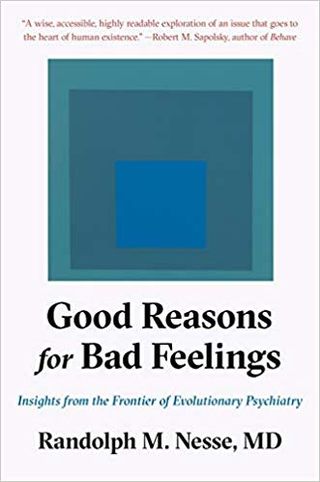Anxiety
When Is It Good for You to Feel Miserable?
A new book explores the functional side of psychopathology.
Posted March 31, 2019 Reviewed by Lybi Ma
Randolph Nesse’s Good Reasons for Bad Feelings is a book I would recommend as required reading for anyone practicing or hoping to practice, clinical psychology, psychiatry, or social work. In fact, I would recommend the book to anyone who suffers from anxiety, depression, or problems controlling their eating, drinking, drug use, or sexual impulses.
Randy Nesse is an evolutionary psychiatrist. He is a founder of the field of evolutionary medicine, and is best known for his earlier book, Why We Get Sick: The New Science of Darwinian Medicine, which he wrote with George C. Williams, the eminent evolutionary biologist. Nesse was also one of the founders of the Human Behavior and Evolution Society, whose initial members were a group of intellectual giants who changed the face of modern evolutionary biology, psychology, and anthropology (E.O. Wilson, William Hamilton, Sarah Hrdy, Napoleon Chagnon, Leda Cosmides, Rob Boyd, Martin Daly, Margo Wilson, John Tooby, Joan Silk, Irenaus Eibl-Eibesfeldt, David Buss, and Richard Dawkins).
The theory of natural selection has completely changed the way we think about virtually every aspect of life, offering insights into the functional significance of aspects of nature from the beautiful peacock’s tail to those nasty parasitic wasps that lay their eggs inside the body of a paralyzed caterpillar. Nesse’s pet peeve is that students of medicine, whose job it is to apply the insights of biology to treating dysfunctions of the body and brain, often do not take a single course in evolutionary biology during their medical training. Instead, medical students tend to focus on the proximate causes of bodily and mental dysfunctions, such as infections and breakdowns in biochemical and immune responses.

What’s wrong with psychiatrists and clinical psychologists not thinking about evolution? Several things, according to Nesse. One big problem is the tendency to treat symptoms as the disease, when in fact they’re often just your mind’s way of responding functionally to an important underlying problem. He contrasts the way a doctor would respond to someone who comes in with severe abdominal pain versus high levels of anxiety or depression. For the abdominal pain patient, the doctor would not simply prescribe pain killers and consider the mission accomplished, he or she would try to determine whether the pain was caused by constipation, ectopic pregnancy, or cancer. But for the patient complaining of high levels of anxiety or depression, it would not be unusual to prescribe a drug that reduces the symptom, and if the drug works, to consider the job done. That is not unlike treating someone with measles by prescribing make-up to cover up the spots.
What’s Good About Anxiety and Depression?
Nesse makes the case that both anxiety and depression can be helpful in inducing you to make necessary course corrections in your life. We inherited a tendency to feel anxious in situations that signal potential harm, and healthy doses of anxiety prevent you from doing dangerous things (see "Does Anxiety Help You Survive in the Modern World?"). Nesse notes that women’s higher level of anxiety, compared to men’s, is potentially a good thing.
Men are many times more likely to die in accidents, due to their motivation to win respect and admiration. Alex Honnold’s willingness to free solo up Yosemite’s precipitous El Capitan without a rope won him great kudos for his bravery and athletic prowess. But if you visit the Wikipedia page listing the world’s greatest free solo climbers, you’ll find that a shockingly high proportion of them died in climbing accidents.
Men’s low levels of anxiety are not a design flaw, though, but the result of a trade-off. As in the case of many vertebrates, a male’s odds of winning a mate go up if he can call attention to his superiority over other males. Females do not typically need to compete as vigorously for mates—they are in a buyer's market because they are already paying the high costs of bearing the young and, in the case of mammals, nursing them afterward.
We also inherited a tendency to feel depressed under circumstances when our efforts are not paying off. Nesse reviews research and theory on what biologists call optimal foraging theory, which deals with the circumstances under which it pays any animal to give up seeking rewards in one spot or at one task (picking berries from a bush, for example) and move to another. There is also evidence that other animals are likely to become lethargic when resources are scarce, and high levels of effort might be dangerous (this is related to why some animals hibernate in the cold winter months). So a depressed mood may be your body’s way of saying that you should simply give up on a course of action that is failing.
What’s the problem with drugs that improve your mood? They hijack your brain into thinking everything is fine. Nesse describes one woman who stopped caring about the demanding tasks on her job after taking drugs to relieve her bad feelings, and several months later was in danger of losing that job, because now she was slacking off with a devil-may-care attitude.
There’s an important caveat—because overwhelming levels of anxiety or sad mood can become problems in themselves, Nesse believes it is often important to treat the symptom, but not without also addressing the underlying environmental problem.
Nesse’s emphasis on the environmental causes of psychopathology highlights a classic misconception about evolutionary psychology—that it is about finding genes and ignores the environment. Quite the opposite, evolutionary researchers are typically interested in studying the links between threats and opportunities in the environment and whether psychological mechanisms are designed to respond adaptively to those threats and opportunities. In the case of psychological problems, it is critical to understand the normal adaptive systems, and the events in the environment that trigger those systems, if one is to solve the problem.
Mismatches, Trade-Offs, and Smoke Detectors
One of the useful ideas that Nesse describes is what evolutionary theorists call "mismatch." Sometimes a system was functional in the ancestral past but is somehow being short-circuited by circumstances in the modern world. As he notes in his chapter on eating disorders, our ancestors mainly had to worry about starvation in a world where the plants and animals they wanted to eat were adapted to avoid being eaten (rabbits are fast and stealthy, and many plants have toxins and sharp thorns, for example). And even when our ancestors could find food, the plants were typically low in sugars, and the prey animals were lean.
But following the agricultural revolution, the food not only stays in place, but the plants are selectively bred to be high in calories (bananas and avocados), and the animals to be pleasantly laced with fat. And with modern food delivery systems, most of us don’t need to burn calories searching for fruits, catching rabbits, or casting nets at the fishing hole, as our ancestors did, we can just satisfy our need for sugars and fats by driving down to the supermarket or the local fast-food outlet. Nesse observes that in the ancestral environment, there would have been very few problems with diabetes, high blood pressure, coronary heart disease, or obesity. But we are still designed for a world in which we moved around for most of the day, and where the calories were typically barely sufficient to sustain life. So we stuff ourselves with pizza and double chocolate fudge ice cream. As a consequence, obesity rates and disorders such as bulimia are rising in the modern world.
Another useful concept that helps us understand costly and dangerous behaviors is the idea of trade-offs. No living organism can ever optimize all its goals, because time and energy devoted to building nests or finding new mates must be taken away from time devoted to finding food or caring for offspring. Time spent hiding from predators is time not spent searching for food. Thinking back to men’s risky behaviors, we noted that they likely result from a trade-off faced by ancestral males—between survival and mating success. Many behaviors that look maladaptive, such as delinquent acting out, may instead be the product of trade-offs.
Another useful idea in Nesse’s book is his "smoke detector metaphor." If you set the smoke detector in your house to go off too easily, it may wake you in the middle of the night with a false alarm when someone passes by on the street smoking a cigarette. But if you set it too conservatively, it may not go off soon enough when there is a real fire in the house. The costs of missing a real fire are many times higher than the costs of being annoyed by a false alarm.
Nesse describes how this might explain overly high levels of anxiety, using the example of avoiding lions. What if one of your ancestors ran every time he heard a sound in the bushes that might possibly have been a lion, and the odds of actually being eaten by a lion were only 1 in 1,000. If he ran away 999 times, it would have been for nothing, and he would have wasted calories. But if he failed to run on that thousandth occasion, he would have been eaten, and you wouldn’t be here to think about it.
Of course, mismatches can come in here also, as our natural smoke detector settings may not apply in the modern world. Sometimes our brains are set to avoid being eaten by lions, and our anxieties prevent us from taking risks that are objectively minimal in the pursuit of goals that might make us quite a bit happier.
Nesse’s book covers a lot of territory, offering evolutionary insights into the whole spectrum of problems covered by the Diagnostic and Statistical Manual of Mental Disorders. He notes in his final chapter that most of the funding for research on mental disorders has gone to studies of specific genes and brain abnormalities responsible for particular dysfunctions. If, however, one accepts his strong arguments that much of human misery stems from the operation of normal adaptive systems, it is easy to accept his conclusion that there will be immense benefits from training all budding psychiatrists and clinical psychologists in the tools of evolutionary thinking.
Below I list a few related thoughts about how to cope with feelings of depression and anxiety:
- "What if your life isn't going so well?": Lists seven research-based suggestions to improve your well-being.
- "Zen and the art of embracing rejection": What’s so good about embracing negative feedback.
- And here's a review of some other research on positive aspects of negative feelings: "7 good things about feeling bad."
- Also complementing Nesse's perspective, there's research suggesting it can actually be harmful to directly seek happiness as an end in itself: "If You Pursue Happiness, You May Find Loneliness."
Facebook Image: Mangostar/Shutterstock
LinkedIn Image: Dragon Images/Shutterstock
References
Nesse, R.M. (2019). Good reasons for bad feelings: Insights from the frontier of evolutionary psychiatry. New York: Dutton




